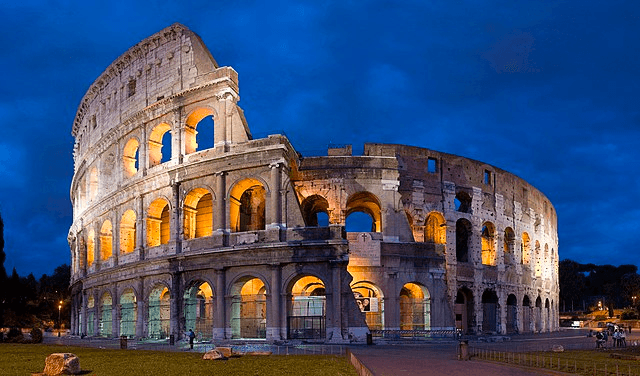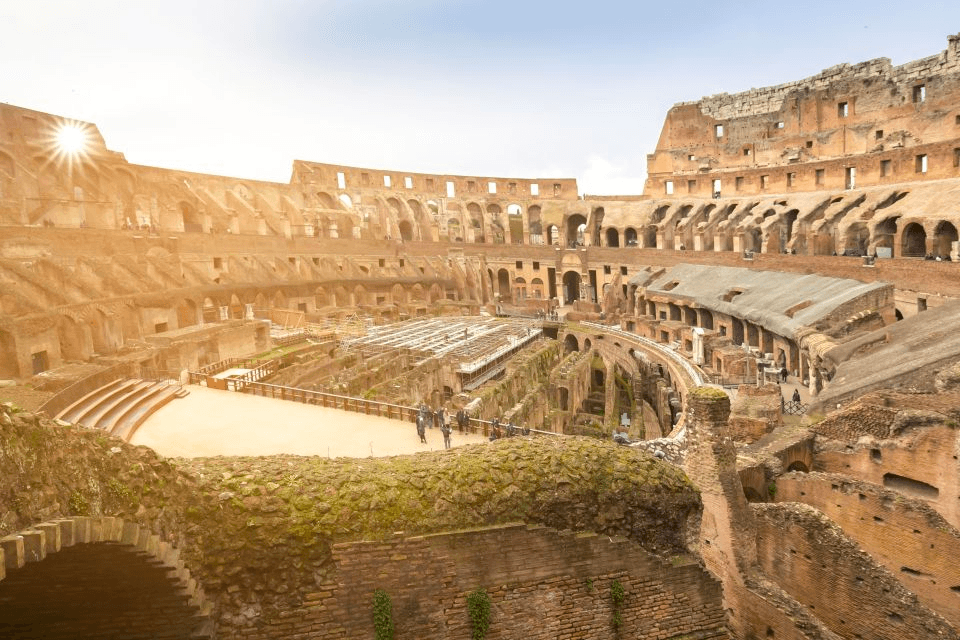À la découverte du Colisée : manuel du voyageur
Comprend des conseils pour obtenir des billets !
Le Colisée de Rome, en Italie, est l'une des structures les plus emblématiques au monde. C'est une attraction incontournable pour tous ceux qui se rendent dans la Ville Éternelle. Le Colisée, également connu sous le nom d'Amphithéâtre Flavien, témoigne de la grandeur et de la puissance de l'Empire romain. Cette arène antique était le plus grand amphithéâtre romain et accueillait autrefois des combats de gladiateurs, des simulations de batailles navales et des chasses aux animaux. Sa structure imposante a résisté à l'épreuve du temps, survivant aux catastrophes naturelles et aux guerres.

Si vous prévoyez de visiter le Colisée, il est important d'être bien préparé afin de profiter au maximum de votre expérience. Voici quelques conseils et astuces pour découvrir le Colisée.
Histoire du Colisée
Avant de visiter le Colisée, il est utile de connaître son histoire. Le Colisée a été construit entre 70 et 80 après J.-C., sous la dynastie des Flaviens, et pouvait accueillir jusqu'à 50 000 spectateurs. Il a été utilisé pendant plus de quatre siècles avant de tomber en désuétude lorsque les jeux de gladiateurs sont passés de mode. Le Colisée a été endommagé par un tremblement de terre en 1349, laissant derrière lui les ruines que nous voyons aujourd'hui. Ce n'est qu'au XIXe siècle que les travaux de restauration ont commencé et jusqu'à aujourd'hui, les efforts pour restaurer le Colisée sont toujours en cours. Aujourd'hui, il est classé au patrimoine mondial de l'UNESCO et constitue une attraction touristique populaire.

À la découverte du Colisée
Le Colisée propose plusieurs zones à explorer. Cependant, tous les billets ne permettent pas d'accéder à toutes les zones. Vous devrez donc savoir exactement ce que vous souhaitez voir avant d'acheter vos billets.
Pour vous aider à décider quoi voir, voici quelques-uns des principaux domaines à connaître :
Arène
L'arène est la partie principale du Colisée, où les gladiateurs se sont battus pour leur vie sous le regard de 50 000 personnes. Aujourd'hui, vous pouvez marcher sur l'arène, mais cela nécessite un billet spécial. Depuis l'arène, vous pouvez avoir une bonne vue d'ensemble du Colisée, y compris une perspective différente des tunnels en dessous.
Sous terre (L'Hypogée)
Les niveaux inférieurs du Colisée étaient utilisés pour le stockage et l'hébergement des animaux, et étaient la « salle de détention » des gladiateurs. Ici, vous en apprendrez plus sur les coulisses du Colisée. En raison de la complexité du labyrinthe de tunnels, les archéologues ont évité cette zone et le souterrain n'a été entièrement ouvert aux visiteurs qu'en 2021. C'est la partie la plus fascinante du Colisée, mais les billets ici sont aussi les plus difficiles à obtenir.
Premier et deuxième niveaux
Les étages supérieurs du Colisée étaient réservés aux spectateurs. De là, vous pourrez voir le Colisée et l'Arène du point de vue d'un spectateur. Au deuxième étage, il y a également des expositions où vous pourrez en apprendre davantage sur l'histoire du Colisée. Un accès spécial n'est pas nécessaire pour visiter cette zone.
Belvédère
Le Belvédère fait référence aux niveaux supérieurs de la structure et offre la meilleure vue sur le Colisée et ses environs. Il s'agit d'une autre zone à accès restreint qui nécessite une visite pour y accéder, mais elle est actuellement fermée pour travaux de restauration.
Forum romain et mont Palatin
Dans les environs du Colisée, vous pouvez également visiter leForum Romain et Mont Palatin. La plupart des billets pour le Colisée vendus sur le site officiel incluent également l'accès à ces deux sites.

Le Forum romain est un complexe de bâtiments gouvernementaux, de temples et de marchés de la Rome antique. Parmi les choses à voir dans le Forum romain, on trouve le temple de Vénus, le temple de Jules César, l'arc de Titus et la Curie (maison du Sénat).

Le mont Palatin abrite de nombreuses fouilles archéologiques et des vestiges de temples. Il y a également un musée, mais l'un des incontournables du mont Palatin est leTerrazzo Belvédère du Palatino, d'où vous aurez l'une des plus belles vues de Rome.
Si vous visitez le Forum romain et le mont Palatin, pour un accès plus rapide et des files d'attente beaucoup plus courtes, il est recommandé d'utiliser l'entrée de la Via Di San Gregorio au lieu de l'entrée du Forum.
Obtenir vos billets
Les billets pour le Colisée sont valables pour des horaires spécifiques et une réservation à l'avance est nécessaire. La seule exception concerne les jours de visite gratuite, où les billets gratuits doivent être récupérés sur place. Il existe plusieurs façons d'obtenir des billets en ligne :
De Coopculture
[Mis à jour le 7 mai] - Le Colisée romain a depuis été retiré de Coopculture
Coopcultureest un site qui vend des billets pour les principales attractions d'Italie. Pour le Colisée, ils proposent plusieurs options de billets parmi lesquelles vous pouvez choisir. Chaque billet donne accès à différentes zones et possède son propre ensemble d'exclusions. Assurez-vous de lire les inclusions et les exclusions du billet pour vous assurer d'acheter le bon billet !
Les billets sont mis en vente exactement 720 heures (ou 30 jours) avant l'heure de la visite, et par lots en fonction de l'heure réelle de la visite. Cela signifie que si vous prévoyez de visiter le musée à 9 h 10 le 30 avril, le billet pour ce créneau horaire sera mis en vente le 1er mars à 9 h 10. Plusieurs créneaux horaires seront mis en vente dans la même journée. Si vous êtes flexible quant à l'heure réelle de la visite, nous vous suggérons d'essayer de réserver une plage horaire et, si vous n'obtenez pas de billet pour un créneau horaire, de rester en ligne et d'essayer de réserver le créneau suivant.
Si vous manquez ces billets, il existe également des billets qui sont mis en vente 7 jours avant, et vous pouvez essayer de les obtenir à la place. Notez que pour chaque jour de visite, vous ne pouvez avoir qu'un maximum de 6 billets.
Auprès de fournisseurs tiers de billetterie et de circuits touristiques
Les sites de billetterie tiers comme Klook ou Viator proposent également des billets pour le Colisée dans le cadre d'une visite. Souvent, ces visites comprennent également une visite du mont Palatin et du Forum romain. Bien que les prix puissent être légèrement plus élevés, ils offrent également une plus grande flexibilité et beaucoup moins de stress au niveau de la billetterie. Une visite guidée peut également améliorer votre visite en vous donnant plus d'informations sur les différents sites.
Voici quelques-uns des circuits les mieux notés par les différentes OTA :
- Viateur: à partir de 65,81 USD, 4,5 étoiles, plus de 2 000 avis
- Obtenez votre guide: à partir de 58,58 USD, 4,6 étoiles, plus de 38 000 avis
- Klook: à partir de 42,05 USD, 4,3 étoiles, plus de 1 000 avis
Passeport Roma
Le Passeport Romaest une carte qui offre des transports, des réductions et des tarifs réduits pour les attractions touristiques, y compris le Colisée. Si vous prévoyez de visiter plusieurs attractions, envisagez plutôt de vous procurer un Roma Pass. Le Roma Pass vous permet également de rejoindre une ligne express pour le Colisée. Notez cependant que le Roma Pass ne vous donne pas accès à l'arène ni au métro.
Conseils de visite

- Comme vous devrez passer un contrôle de sécurité, prévoyez d'arriver au moins 15 minutes avant l'heure d'entrée prévue.
- Portez des chaussures confortables car il y a beaucoup de marche à faire. Apportez de la crème solaire et un chapeau pendant les mois d'été car le soleil peut être intense.
- Les mois d'été, en juillet et août, sont ceux où la fréquentation est la plus importante. Pour éviter les foules, essayez d'obtenir un billet pour les premiers créneaux horaires de la journée.
- Méfiez-vous des pickpockets, surtout pendant les périodes de pointe où les lieux sont les plus fréquentés.
Horaires d'ouverture
- Du 2 janvier au 28 février : 9h00 - 16h30
- Du 1er au 26 mars : 9h00 - 17h30
- Du 27 mars au 31 août : 9h00 - 19h15
- Du 1er septembre au 30 septembre : 9h00 - 19h00
- Du 1er au 30 octobre : 9h00 - 18h30
- Du 31 octobre au 31 décembre : 9h00 - 16h30
Dernière admission une heure avant la fermeture.